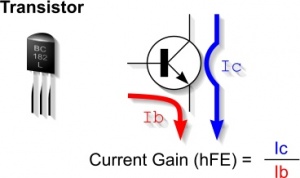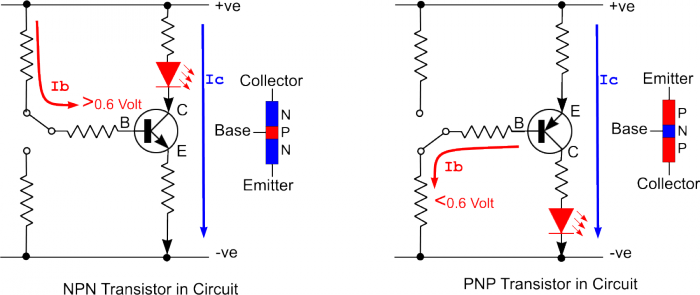Transistor: Difference between revisions
From DT Online
m (Corrected category link) |
(Added transistor types) |
||
| Line 1: | Line 1: | ||
[[File:Transistor2.jpg|300px|right]] | [[File:Transistor2.jpg|300px|right]] | ||
[http://en.wikipedia.org/wiki/Transistor '''Transistors'''] are used as electronic ''[[switches]]'' and current amplifiers. They have three ‘legs’ - base , collector and emitter. A small current to the base switches on the transistor allowing a much larger current to flow between collector and emitter. | [http://en.wikipedia.org/wiki/Transistor '''Transistors'''] are used as electronic ''[[switches]]'' and current amplifiers. They have three ‘legs’ - base , collector and emitter. A small current to the base switches on the transistor allowing a much larger current to flow between collector and emitter. | ||
The current gain of a transistor ''(hFE)'' is the ratio of the current flowing through the collector, to the current flowing through the base. It is a measure of the transistor's ability to amplify current ''(hFE = Ic/Ib)''. | The current gain of a transistor ''(hFE)'' is the ratio of the current flowing through the collector, to the current flowing through the base. It is a measure of the transistor's ability to amplify current ''(hFE = Ic/Ib)''. | ||
They come in various different shapes and sizes and it is important to decide which type is required at the outset. Factors to be considered are voltage and power handling capacities, cost and availability. | They come in various different shapes and sizes and it is important to decide which type is required at the outset. Factors to be considered are voltage and power handling capacities, cost and availability. | ||
Transistors come in '''NPN''' and '''PNP''' types. It is important to use the correct type when designing and building circuits. | =====Transistor Types===== | ||
Transistors come in '''NPN''' and '''PNP''' types. It is important to use the correct type when designing and building circuits. | |||
[https://en.wikipedia.org/wiki/Bipolar_junction_transistor#NPN '''NPN transistors'''] are most commonly used in schools for control circuits. They require a base voltage of at least 0.6V with respect to the emitter to ‘turn on’. ''([http://en.wikipedia.org/wiki/Darlington_transistor '''Darlington Pair transistors'''] require 1.2 V)''. A limiting resistor - typically 1K is required in the base circuit of the transistor stage to prevent over-running and hence overheating and destruction of the transistor. | |||
[[File:TransistorTypes.png|700px|below]] | |||
<div style="clear: both;"></div> | |||
[https://en.wikipedia.org/wiki/Bipolar_junction_transistor#PNP '''PNP transistors'''] ‘turn on’ when the base current falls below 0.6V with respect to the emitter. Hence, NPN transistors are said to ‘source’ current and PNP transistors ‘sink’ current. | |||
=====History and Development===== | |||
Transistors were developed as the result of some work at the [http://en.wikipedia.org/wiki/Bell_Labs '''Bell Telephone Labs.'''] in 1948 by a team comprising [http://en.wikipedia.org/wiki/William_Shockley '''William Shockley, John Bardeen and Walter Houser'''] - in 1956 the team were jointly awarded a [http://en.wikipedia.org/wiki/Nobel_Prize_in_Physics '''Nobel Prize in Physics'''] for this work. | |||
The main material, silicon, can be made into a conductor by '''''doping''''': a process of adding impurities to the silicon crystal. Adding phosphorus or arsenic creates N-type Silicon ''(negatively charged)'' whereas adding boron or gallium produces P-type Silicon ''(positively charged)''. | |||
Combining layers of the two types of silicon side by side produces a '''[[Diode]]'''. The transistor is essentially a [https://en.wikipedia.org/wiki/Triode '''Triode'''] built up from a thin central layer of one type of silicon semiconductor sandwiched between two thicker pieces of the other type - i.e. either NPN or PNP. | |||
Revision as of 12:37, 31 May 2015
Transistors are used as electronic switches and current amplifiers. They have three ‘legs’ - base , collector and emitter. A small current to the base switches on the transistor allowing a much larger current to flow between collector and emitter.
The current gain of a transistor (hFE) is the ratio of the current flowing through the collector, to the current flowing through the base. It is a measure of the transistor's ability to amplify current (hFE = Ic/Ib).
They come in various different shapes and sizes and it is important to decide which type is required at the outset. Factors to be considered are voltage and power handling capacities, cost and availability.
Transistor Types
Transistors come in NPN and PNP types. It is important to use the correct type when designing and building circuits.
NPN transistors are most commonly used in schools for control circuits. They require a base voltage of at least 0.6V with respect to the emitter to ‘turn on’. (Darlington Pair transistors require 1.2 V). A limiting resistor - typically 1K is required in the base circuit of the transistor stage to prevent over-running and hence overheating and destruction of the transistor.
PNP transistors ‘turn on’ when the base current falls below 0.6V with respect to the emitter. Hence, NPN transistors are said to ‘source’ current and PNP transistors ‘sink’ current.
History and Development
Transistors were developed as the result of some work at the Bell Telephone Labs. in 1948 by a team comprising William Shockley, John Bardeen and Walter Houser - in 1956 the team were jointly awarded a Nobel Prize in Physics for this work.
The main material, silicon, can be made into a conductor by doping: a process of adding impurities to the silicon crystal. Adding phosphorus or arsenic creates N-type Silicon (negatively charged) whereas adding boron or gallium produces P-type Silicon (positively charged).
Combining layers of the two types of silicon side by side produces a Diode. The transistor is essentially a Triode built up from a thin central layer of one type of silicon semiconductor sandwiched between two thicker pieces of the other type - i.e. either NPN or PNP.

